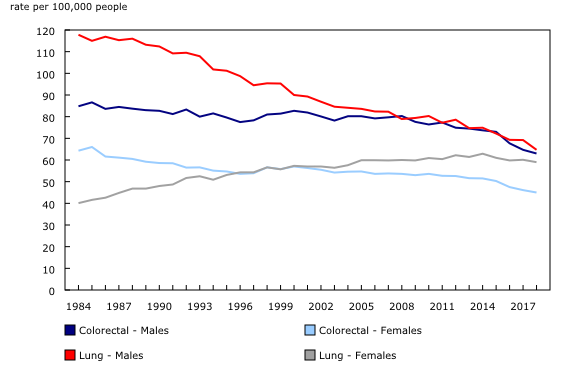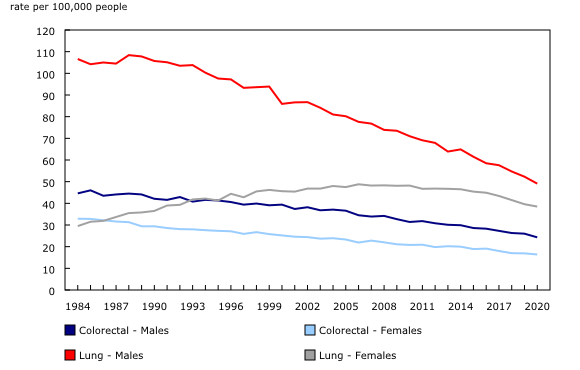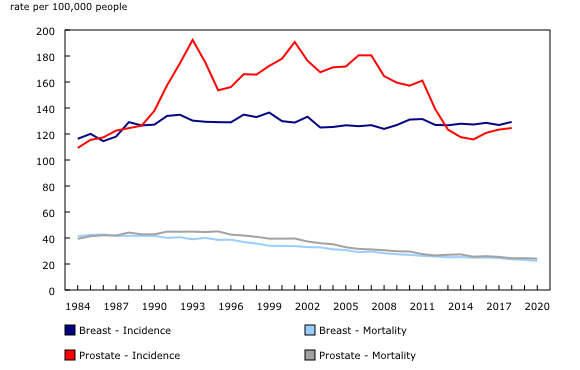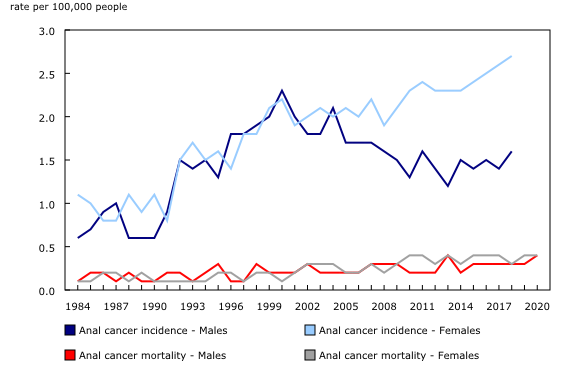Cancer incidence and mortality trends, 1984 to 2020
Archived Content
Information identified as archived is provided for reference, research or recordkeeping purposes. It is not subject to the Government of Canada Web Standards and has not been altered or updated since it was archived. Please "contact us" to request a format other than those available.
Released: 2022-02-04
Cancer affects the lives of many people living in Canada. It is estimated that 43% of Canadians will be diagnosed with cancer in their lifetime, and cancer remains the leading cause of death. Examining the latest trends in the rates of diagnosis (incidence rates) and death (mortality rates) of cancer is useful for identifying emerging patterns and assessing the extent of the progress made in the fight against the disease. While several trends have been observed for different combinations of sex and cancer type over the past 35 years, all the trends described in this article are the most recent ones and have been observed for a minimum duration of five years.
Recent decline in both cancer incidence and mortality rates
Since 2011, the incidence rate for all cancers combined has been decreasing by a small, but statistically significant, 0.6% annually. This recent decline has been larger among males (-1.2% per year) than among females (-0.5% per year). These estimates denote improvements on earlier incidence trends since cancer incidence increased slightly for over three decades before initiating this decline.
At the same time, the overall cancer mortality rate has also been decreasing by 2.2% per year, with a downward trend of -2.3% per year among females and of -1.8% per year among males. These downward trends represent an improvement of about 70% over the previous decreasing trend of -1.3% per year that had been observed from the early 2000s until the mid-2010s.
Lung and colorectal cancer incidence and mortality rates decrease
Lung and colorectal cancers rank among the most commonly diagnosed cancers and are the two leading causes of cancer mortality in Canada. However, significant progress in the fight against cancer has been made over the past few years, leading to a noteworthy decline of both their incidence and mortality rates. Since 2014, the lung cancer incidence rate has undergone an annual decrease of 2.3%, with a steeper downward trend for males (-3.4% per year) than females (-1.5% per year). In contrast, all the trends previously observed among females since 1984 were upward ones. Moreover, both the male (-4.3% per year) and female (-4.1% per year) lung cancer mortality rates have decreased rapidly since the mid-2010s. The observed difference between males and females in lung cancer mortality over time largely reflects past differences in smoking prevalence. Trends in mortality follow trends in incidence but are also influenced by the recent advances in lung cancer treatment and survival.
Starting in 2014, the colorectal cancer incidence rate has declined by 3.9% per year. As with lung cancer, this recent decline is steeper for males (-4.4% per year) than females (-3.5% per year). This decrease in incidence rate represents a marked improvement over the previous trend (-0.7% per year from the early 2000s to the mid-2010s) and closely mirrors the recent decrease of the colorectal cancer mortality rate (-3.4% per year). Colorectal cancer screening has played a major role in the reduction of incidence and mortality rates in recent years.
Decreasing mortality rates for breast and prostate cancer
Breast and prostate cancer are the most commonly diagnosed cancers among each sex respectively. While their incidence has remained relatively stable recently, both cancers have undergone a significant decrease in mortality over the past decade (female breast: -1.5% per year; prostate: -1.6% per year) as a result of organized screening, early detection and effective treatment. However, different trends seem to characterize some other sex-specific cancers. Both the incidence (+1.1% per year) and mortality rates (+1.9% per year) associated with uterine cancer have increased. Testicular cancer incidence has also exhibited a steady annual increase of 1.3% for over three decades. While some risk factors such as obesity and diabetes have been linked to uterine cancer, testicular cancer tends to be diagnosed among younger males and remains relatively hard to prevent.
Increasing mortality rate for anal cancer
One of the strongest increases in cancer mortality over the entire study period (1984 to 2020) was noted for anal cancer (+3.3% per year). This cancer, which remains rare in the population, is strongly associated with some specific strains of the human papillomavirus (HPV). Its incidence has been rising lately in the female population (+1.5% per year) but, according to a Statistics Canada study, its survival has not improved over the past 25 years. However, it is expected that HPV vaccination, which has been available in publicly funded school-based programs in all provinces and territories since 2017, will contribute to reverse these trends. The Canadian Partnership Against Cancer has reported provincial and territorial immunization uptake proportions ranging from 57.1% to 91.3% for girls and from 57.5% to 91.3% for boys.
Note to readers
The statistics presented above report the annual percent change in age-standardized cancer incidence and mortality rates for the latest period for which data were available. Models were constrained to report trends over periods lasting for a minimum duration of five years. As a consequence, the latest possible period considered for incidence was 2014–2018, whereas it was 2016–2020 for mortality. The trends reported in Table 10-13-0839-01 and Table 10-13-0840-01 were calculated using the United States National Cancer Institute's Joinpoint Regression Program and applied to incidence and mortality rates that were age-standardized using the 2011 Canadian Standard Population. A maximum of five trends were retained over the entire period of interest (1984–2018 for incidence and 1984–2020 for mortality). The corresponding time periods (start and end year) are also reported in both tables.
The Canadian Cancer Registry (CCR) is a population-based registry that includes data collected and reported to Statistics Canada by each Provincial/Territorial Cancer Registry. The goal of the person-based CCR is to collect information about each new primary cancer diagnosed among Canadian residents since 1992. Incidence data for the 1984–1991 diagnosis years were drawn from the National Cancer Incidence Reporting System, a tumour-based national cancer incidence database which predated the CCR and contains data covering the 1969–1991 reference period.
The Canadian Vital Statistics Database – Deaths is an administrative database that collects demographic and medical (cause of death) information annually and monthly from all provincial and territorial vital statistics registries on all deaths in Canada.
Cancer incidence data for Quebec are not available for diagnosis years 2011 onward. Therefore, the cancer incidence trends presented in Table 10-13-0840-01 are for Canada excluding Quebec. For comparability purposes, the same series was created for cancer mortality in Table 10-13-0839-01 in addition to the complete national series.
Some imputation was performed on the original data. For incidence, the cases whose sole method of confirmation of the cancer diagnosis was the death certificate were imputed for the provinces of Manitoba (2013–2018) and Nova Scotia (2018). For mortality, the data for the Yukon territory were missing for the 2017–2020 period and were also imputed using a similar methodology.
When considering all-cancer incidence, non-melanoma skin cancer is excluded but in situ bladder cancer cases are included.
Contact information
For more information, or to enquire about the concepts, methods or data quality of this release, contact us (toll-free 1-800-263-1136; 514-283-8300; infostats@statcan.gc.ca) or Media Relations (statcan.mediahotline-ligneinfomedias.statcan@statcan.gc.ca).
- Date modified:





